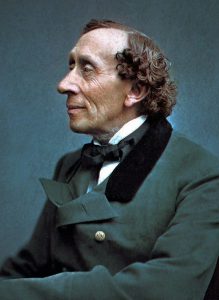 Pin
Pin To begin with, Hans Christian Andersen seemed fated to live a life of ill-luck. Born at Odense, on one of the islands of Denmark, he spent the early part of his life living in a single room with his mother and father, a cobbler who had suffered from ill health for most of his life. Hans, however, was a great consolation to the cobbler, who had high hopes for his son, although there were those in the village who thought the lad simple-minded. The only time Hans was really happy was when his father took him for a walk.
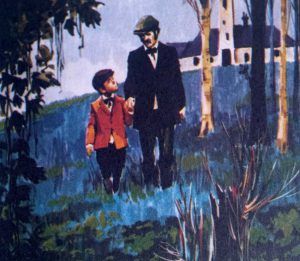 Pin
Pin  Pin
Pin The cobbler died when Hans was about eleven, leaving his widow to bring up their son alone. Hans was still allowed to go to school, but somehow his mind seemed quite unable to absorb even the simplest subjects. His burning ambition was to become an actor, and whenever a theatrical company came to Odense, he begged the manager to allow him to play some small role in the play. Finally, given his big chance by a kindly manager, he appeared only to be laughed off for his clownish appearance.
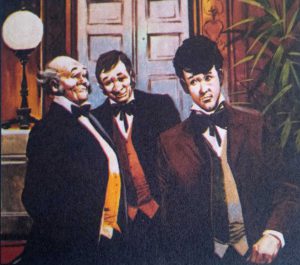 Pin
Pin Undeterred by his disastrous stage debut, Hans spent all his spare time playing with the toy theatre his father had given him, making his puppets act out the plays of Shakespeare. To improve his voice, he read aloud the verses and plays he had written for his theatre. No one in Odense could see that he had gifts that only needed developing, and his life was therefore a lonely one.
In despair, his mother finally decided that her son had spent enough of his life day-dreaming, and she announced that she was going to apprentice him to a tailor. Appalled at the thought of having to spend the rest of his life sewing garments, Hans begged her to allow him to go to Copenhagen instead, where he was sure he would find fame and fortune on the boards of the city’s theatres. Reluctantly, she gave her consent, and he set off with only a few coins in his pocket and no friends to turn to when he arrived in the capital. He was only 14.
On his arrival, he made his way directly to the Royal Theatre, where he asked if he might be allowed to see the directors. Ushered into their presence, he announced to them that he wanted to be an actor. The directors looked at the thin, uncouth boy standing humbly in front of them. Then they looked at each other — and burst out laughing. With the sound of their laughter ringing in his ears, Hans left the theatre.
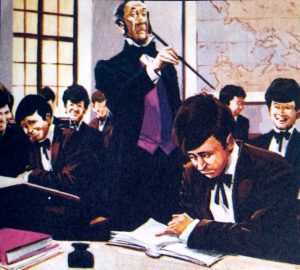 Pin
Pin As it happened, however, the interview had been overheard by a poet and playwright named Friedrik Guidberg, who had an instinctive feeling that there was much more to Hans than appeared on the surface. He pleaded with the directors to give the boy a chance. Reluctantly they promised to do something for him.
But several weeks passed before ‘something was done’, for Hans had not told the directors that he was penniless and without a home. Starving and friendliness, he wandered the streets of Copenhagen, sleeping in alleyways and parks at night.
At last, the directors redeemed their promise and accepted Hans as a pupil. But their original estimate of him as a potential actor proved only too true. They soon discovered that Hans could not act at all. Furthermore, his voice had broken and he was not even able to sing in the chorus.
Fortunately, one of the directors took pity on him and sent him to school once more. But Hans remained a backward and unwilling pupil, and there followed five of the darkest and bitterest years of his life. His eccentric manner and slow wits made him the butt of his classmates, who tormented him unmercifully. In addition, his habit of quietly sitting in a corner and writing verse when he should have been studying his text books, infuriated his masters, who were not slow to show their displeasure with this impossible pupil who had been foisted on them.
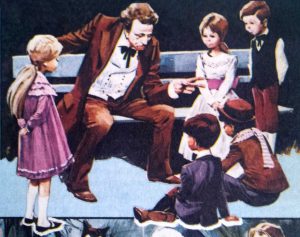 Pin
Pin But Hans’ luck was to change. After trying to write every form of literature without success, one of his plays was put on at the Royal Theatre, where it had a modest success. Four years later, his first book of fairy tales appeared, and very soon afterwards he woke up one morning to find himself famous.
Hans never ceased to be amazed at his success. Originally, he had begun to write down his fairy tales merely to amuse the many little friends he had made in Copenhagen, and it truly astonished him to find that grown-ups enjoyed them just as much as did the children.
He began to travel widely, but he still continued writing, until his fame had grown to such a degree that he was welcome in the houses of people even more famous than himself, including Charles Dickens and Richard Wagner.
Although he was justifiably proud of his international reputation, he remained a modest, easily-hurt man who was always happiest in the company of children, whom he could hold spell-bound with the stories he made up for them on the spot.
 Pin
Pin Hans Christian Andersen had a rare quality. Although he had learned to become a man, he had never lost the innocence of a child. “How beautiful the world is,” he remarked just before his death in 1875, “and how happy I am.” It was a strange path indeed that Hans had followed to bring him to this contented state of mind, despite all the suffering he had endured as a child.
Authors are not always reliable in judging their own work, and Hans was no exception. He had always dismissed his stories as trifles, but it was these rather than his plays and verse, that gained him immortality. Stories such as The Tinder Box, The Snow Queen and The Ugly Duckling have a timeless charm about them that will continue to enchant countless generations of children to come.
About Hans Christian Andersen
Hans Christian Andersen, born on April 2, 1805, in Odense, Denmark, was a renowned Danish author and poet famous for his fairy tales. He is often referred to as the “Father of Fairy Tales” and has made a significant impact on children’s literature worldwide. However, before achieving success, Andersen’s early life was far from glamorous.
Andersen was born into a humble family, and his father, Hans Andersen Sr., worked as a cobbler, repairing shoes for a living. Andersen’s mother, Anne Marie Andersen, was a washerwoman who would take in laundry to support the family. As the son of a cobbler, young Hans faced many hardships and lived in poverty throughout his childhood.
Despite their financial struggles, Andersen’s parents recognized their son’s intelligence and encouraged him to pursue an education. At a young age, Andersen exhibited a love for literature and storytelling, often entertaining his classmates and later the townspeople with his vivid imagination and creativity.
In 1819, at the age of 14, Andersen left his hometown of Odense and traveled to Copenhagen to seek his fortune. He had big dreams of becoming an actor, but after several failed attempts, he turned to writing instead. Andersen wrote his first play, “The Taller, the Better,” in 1822, which garnered some recognition and led to a small grant to continue his education.
Andersen’s breakthrough came in 1835 when he published his first collection of fairy tales titled “Fairy Tales Told for Children.” This collection contained nine stories, including classics like “The Tinderbox,” “Little Claus and Big Claus,” and “The Princess and the Pea.” The book was an instant success and received critical acclaim for its imaginative stories and engaging storytelling style.
Over the next few decades, Andersen wrote and published numerous fairy tales, enchanting readers with his whimsical narratives and heartfelt characters. Some of his most beloved works include “The Little Mermaid,” “The Ugly Duckling,” “The Emperor’s New Clothes,” “The Snow Queen,” and “Thumbelina.” His stories often carried moral messages, teaching children and adults alike the virtues of kindness, empathy, and perseverance.
Despite his success as an author, Andersen’s personal life was somewhat turbulent. He never married or had any children, and his biographers speculate that he may have struggled with his sexuality, which was a taboo subject during his time. Nevertheless, Andersen remained dedicated to his craft and continued to write until his death in 1875.
Hans Christian Andersen’s fairy tales have stood the test of time and have been translated into numerous languages, making them accessible to readers across the globe. His stories have been adapted into films, plays, and animations, cementing Andersen’s status as one of the most influential and celebrated storytellers in history.
Andersen’s legacy lives on, and his works continue to inspire and captivate generations of readers. From the humble beginnings as the son of a cobbler, he defied societal expectations and crafted timeless tales that have touched the hearts of millions. Hans Christian Andersen’s stories serve as a reminder that dreams can come true, no matter the circumstances, and that imagination knows no bounds.
Hans Christian Andersen, a Danish writer and poet in the 19th century, is renowned for his fairy tales that have become a fundamental part of global literature. His stories differ from traditional fairy tales of the time in several ways. Here are some of his key fairy tales and their unique characteristics:
- 1. “The Little Mermaid” (1837): Unlike traditional fairy tales with happy endings, this story portrays a tragic ending for the mermaid who gives up everything for love. It focuses on sacrifice, unrequited love, and the consequences of longing for an unreachable desire.
- 2. “The Ugly Duckling” (1843): In this tale, Andersen emphasizes the theme of identity and self-acceptance. The main character, initially rejected because of his appearance, later discovers he is a beautiful swan. It highlights the importance of individuality and the journey towards finding oneself rather than conforming to societal expectations.
- 3. “The Emperor’s New Clothes” (1837): This story satirizes human vanity and exposes the flaws of authority. It revolves around an emperor who is tricked into believing he wears invisible clothes, exposing his gullibility and the people’s fear of speaking up against obvious falsehoods. Andersen uses this tale to criticize hypocrisy and conformity.
- 4. “The Little Match Girl” (1845): This is a somber tale that addresses poverty, suffering, and compassion. It follows a little girl who tries to sell matches in the freezing cold but eventually succumbs to the harsh conditions. Andersen portrays a deeply compassionate character who finds solace in her imagination, emphasizing the importance of empathy and kindness towards those in need.
- 5. “The Snow Queen” (1844): This story follows the journey of a young girl named Gerda to rescue her friend Kai, who has been taken away by the Snow Queen. It introduces themes of friendship, love, and perseverance. Andersen presents a strong female protagonist and promotes the power of innocence and determination in overcoming challenges.
Andersen’s fairy tales differed from traditional ones primarily in their exploration of deeper psychological and moral themes as opposed to simple entertainment. They incorporated social criticism, introspection, and introspective messages, making them relatable and meaningful for readers of various ages and cultures.
Hans Christian Andersen's upbringing as the son of a cobbler had a significant influence on his writing of fairy tales. Here are a few ways in which it impacted his work:
- 1. Imagination and Creativity: Growing up in a small, impoverished household, Andersen had limited resources for entertainment. This led him to foster a rich imagination and develop a keen sense of creativity. He would often invent stories and create characters to escape the realities of his surroundings. This imaginative upbringing laid the foundation for his later fairy tales, which are known for their whimsical characters and magical settings.
- 2. Empathy for the Underprivileged: Andersen’s father worked as a cobbler, a profession associated with low social status at that time. Andersen’s own experiences of societal inequality and financial struggles allowed him to empathize with the underprivileged. This empathy is reflected in many of his fairy tales, which often touch upon themes of social class, poverty, and the struggles faced by ordinary people. Through his stories, Andersen championed the idea of kindness, empathy, and the inherent worth of every individual.
- 3. Themes of Transformation: Cobbler’s work revolves around transforming raw materials into something beautiful and functional. This theme of transformation is evident in Andersen’s fairy tales as well. Many of his stories feature characters who undergo significant transformations, whether physical or emotional, highlighting the importance of personal growth and self-discovery. This could be attributed to his exposure to his father’s work, as Andersen saw firsthand how something ordinary could be transformed into something extraordinary through craftsmanship.
- 4. Appreciation for Simple Pleasures: Andersen’s humble upbringing instilled in him an appreciation for the simple pleasures of life. The scarcity of material wealth during his childhood meant that Andersen found joy in the small things—nature, literature, and human connections. This appreciation for simplicity is reflected in his fairy tales, where he often portrays the beauty and value of the natural world and emphasizes the importance of finding happiness in the small moments.
Hans Christian Andersen’s upbringing as the son of a cobbler influenced his writing by shaping his imagination, developing empathy for the underprivileged, inspiring themes of transformation, and fostering an appreciation for the simple pleasures of life.
Hans Christian Andersen's fairy tales had a profound impact on the literary world
Hans Christian Andersen’s fairy tales had a significant impact on the literary world. Firstly, they transformed the genre of fairy tales themselves. Prior to Andersen, fairy tales were largely traditional folk tales with moral lessons. Andersen introduced a more personal and emotional style to the genre. His tales explored complex themes such as social inequality, the challenges of growing up, and the search for identity.
Andersen’s fairy tales also brought about a shift in the target audience. While fairy tales were previously aimed at adults, Andersen specifically wrote for children. He recognized the importance of capturing a child’s imagination and delivering moral messages in an accessible way. This approach revolutionized children’s literature and helped establish the modern concept of literature tailored to young readers.
These tales have remained popular for several reasons. Firstly, Andersen’s narratives possess a timeless quality that transcends the era in which they were written. The themes and emotions explored in his stories, such as love, friendship, and perseverance, resonate with readers of all ages throughout different time periods and cultures.
Secondly, Andersen’s use of vivid descriptions and rich imagery creates a world that continues to captivate readers. His stories are filled with fantastical elements, magical creatures, and enchanting settings, which contribute to their enduring popularity.
Furthermore, Andersen’s tales often contain underlying moral lessons that are still relevant today. The tales address universal themes like self-acceptance, the pursuit of dreams, and the importance of empathy. These timeless lessons make Andersen’s fairy tales relatable and valuable for readers of all generations.
Hans Christian Andersen’s fairy tales had a profound impact on the literary world by transforming the genre, shifting the target audience, and exploring complex themes. Their enduring popularity can be attributed to their timeless appeal, captivating imagery, and the valuable moral lessons they convey.
Some of the challenges and obstacles that Hans Christian Andersen faced in his journey from being a cobbler's son to becoming a renowned and celebrated author include:
- 1. Poverty and humble background: Andersen was born into a poor family, and his father worked as a cobbler. This meant that he didn’t have access to the same privileges and resources as children from wealthier families, which made his journey more challenging.
- 2. Lack of formal education: Due to his family’s financial situation, Andersen initially had limited access to formal education. He attended a few schools as a child, but his education was sporadic. This posed a challenge for him in terms of acquiring knowledge, refining his writing skills, and gaining cultural exposure.
- 3. Social class barriers: In the 19th century, Denmark’s society was highly stratified, and social mobility was challenging for individuals from lower social classes. This meant that Andersen faced prejudice and discrimination due to his background, which could hinder his progress and opportunities for recognition.
- 4. Rejection and criticism: Andersen faced significant rejection and criticism in his early writing career. Publishers were initially hesitant to publish his works, and critics often dismissed or ridiculed his stories as being too simplistic or childish. Overcoming these setbacks required resilience and determination.
- 5. Language barriers: Andersen wrote primarily in Danish, but he faced challenges in reaching international audiences due to language barriers. Translations of his works were not always readily available, which limited his exposure and impact outside of Denmark.
- 6. Academic and literary circles’ skepticism: Throughout his career, Andersen struggled to gain recognition and acceptance from the academic and literary elites of his time. Some critics considered his work to be lowbrow or lacking in depth, which made it harder for him to establish himself as a respected author.
Despite these challenges and obstacles, Andersen persevered, honed his craft, and eventually achieved worldwide acclaim for his fairy tales, poems, and novels. His perseverance, imagination, and unique storytelling abilities helped him overcome the barriers he faced and become one of the most influential authors in literary history.
Frequently Asked Questions: Hans Christian Andersen
Cobbler’s Son is a nickname given to Hans Christian Andersen, a Danish author, best known for his fairy tales.
Cobbler’s Son, or Hans Christian Andersen, wrote many famous fairy tales including “The Little Mermaid,” “The Ugly Duckling,” “The Emperor’s New Clothes,” “The Princess and the Pea,” “Thumbelina,” “The Snow Queen,” “The Steadfast Tin Soldier,” and many more.
Cobbler’s Son began writing fairy tales in the early 19th century. His first collection of fairy tales, “Fairy Tales Told for Children”, was published in 1835.
Cobbler’s Son’s fairy tales are often characterized by their imaginative and symbolic elements. Unlike traditional fairy tales that often had moral lessons, his stories explored complex themes such as personal growth, individualism, and the struggles of the human condition.
“The Little Mermaid” is arguably one of Cobbler’s Son’s most famous fairy tales. It has been adapted into numerous films, musicals, and stage productions, and remains a beloved story across the globe.
Cobbler’s Son’s fairy tales revolutionized children’s literature by moving away from traditional moralistic tales and introducing more nuanced and emotionally resonant narratives. His stories paved the way for the modern fairy tale genre.
Yes, Cobbler’s Son was a prolific writer and produced many other works including novels, plays, poems, travelogues, and autobiographical writings. However, he is best remembered for his fairy tales.
Cobbler’s Son’s humble upbringing and struggles with poverty greatly influenced his fairy tales. His own experiences with loneliness, rejection, and the desire for acceptance are often mirrored in the characters and themes of his stories.
Yes, Cobbler’s Son’s fairy tales have been translated into numerous languages. His stories have amassed worldwide popularity, making him one of the most translated authors in history.
Cobbler’s Son’s fairy tales continue to be celebrated and cherished by readers of all ages. His stories have inspired countless adaptations, films, and illustrations, ensuring that his legacy as an iconic fairy tale writer lives on.


































